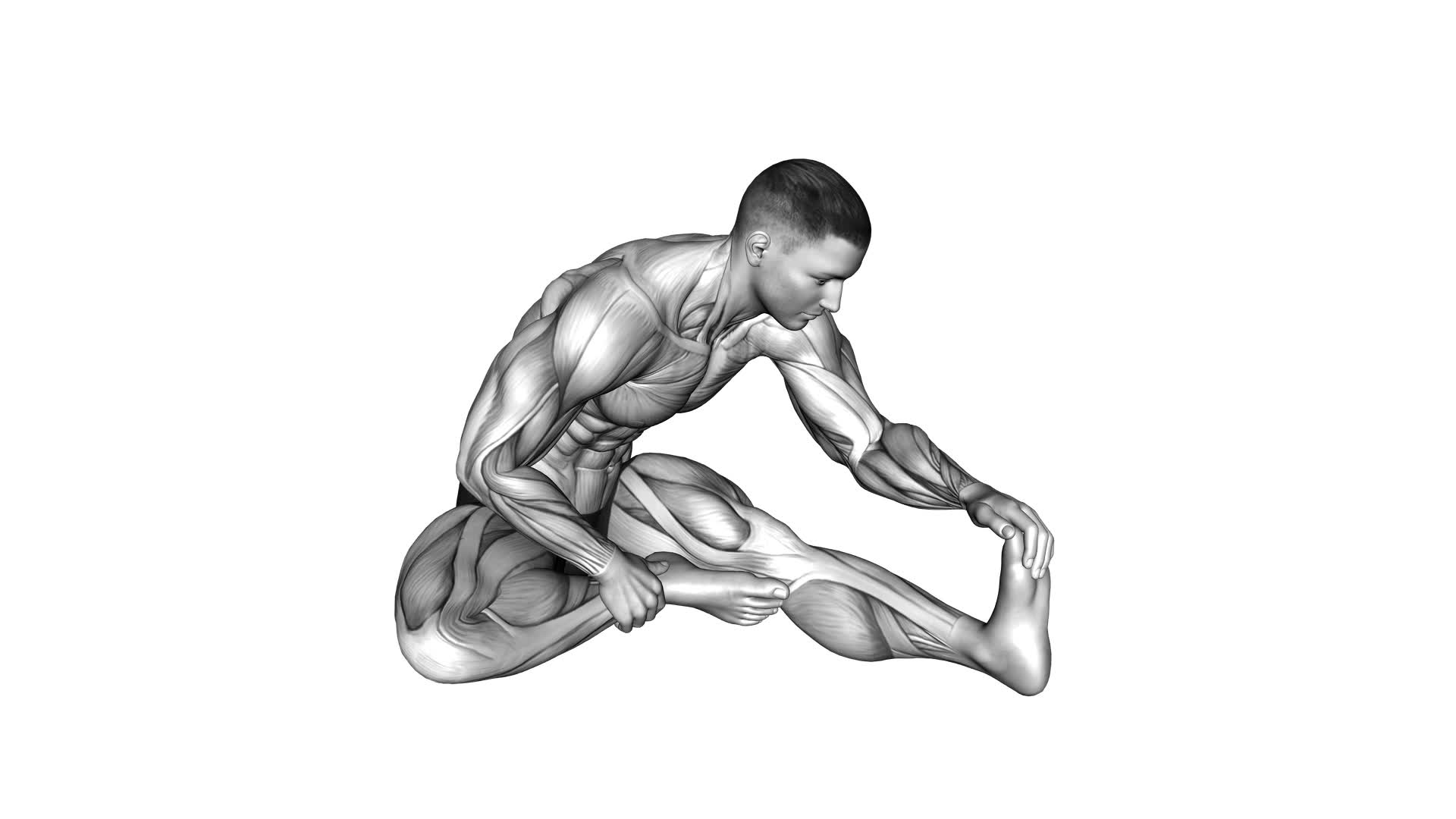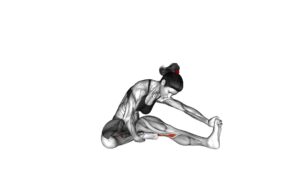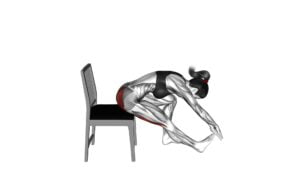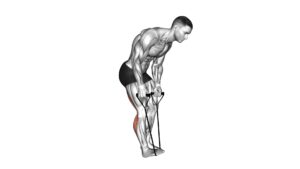Seated Single Leg Hamstring Stretch (male) – Video Exercise Guide & Tips

Are you looking to improve your hamstring flexibility?
Watch This Exercise Video
In this article, we'll guide you through the seated single leg hamstring stretch.
This stretch targets your hamstrings and can help alleviate tightness.
Learn the proper technique, key benefits, common mistakes to avoid, and tips to enhance the effectiveness of this stretch.
Whether you're a beginner or more advanced, we'll also provide variations and progressions to challenge yourself.
Get ready to improve your flexibility with this simple yet effective stretch!
Key Takeaways
- Seated Single Leg Hamstring Stretch improves flexibility in hamstrings.
- Seated Single Leg Hamstring Stretch helps prevent hamstring injuries.
- Seated Single Leg Hamstring Stretch alleviates tightness and discomfort in legs.
- Seated Single Leg Hamstring Stretch increases range of motion for better movement.
Proper Technique: Seated Single Leg Hamstring Stretch
To perform the seated single leg hamstring stretch properly, extend your leg in front of you and grasp your foot with your hand. This stretch is great for improving hamstring flexibility and can be modified for different levels of flexibility.
Begin by sitting on the floor with your legs extended in front of you. Bend one knee and bring the foot towards your inner thigh. Extend the other leg in front of you, keeping it straight. Reach forward with both hands and grasp the foot of the extended leg. Keep your back straight and engage your core.
Gently pull your toes towards your body, feeling a stretch in the back of your leg. Hold this position for 20-30 seconds, focusing on breathing deeply and relaxing into the stretch. Repeat on the other side.
To modify this stretch, you can use a strap or towel to help reach your foot if flexibility is limited. Loop the strap around the arch of your foot and hold onto the ends with your hands. Use the strap to gently pull your foot towards you, feeling the stretch in your hamstring.
Remember to always listen to your body and never push yourself too far. With regular practice, you'll improve your hamstring flexibility and experience the benefits of this seated hamstring stretch.
Key Benefits of the Seated Single Leg Hamstring Stretch
One major benefit of the seated single leg hamstring stretch is that it helps improve flexibility in your hamstrings. Flexibility is crucial for overall fitness and performance in various physical activities. By regularly performing this stretch, you can gradually increase the range of motion in your hamstrings, allowing you to move more freely and efficiently.
Improving flexibility in your hamstrings can also help prevent hamstring injuries. Hamstring strains and pulls are common among athletes and individuals who participate in activities that require quick and forceful movements, such as running or jumping. Tight hamstrings are more prone to injury as they can limit the ability of the muscles to absorb and distribute forces effectively. By regularly stretching and increasing the flexibility of your hamstrings, you can reduce the risk of strain or pull during physical activities.
In addition to injury prevention, the seated single leg hamstring stretch can also help alleviate tightness and discomfort in the back of the legs. Many people experience tight hamstrings due to prolonged sitting or lack of physical activity. By incorporating this stretch into your routine, you can relieve tension in the hamstrings and promote better overall muscle balance and posture.
Now that you understand the key benefits of the seated single leg hamstring stretch, let's move on to discussing some common mistakes to avoid during this stretch.
Common Mistakes to Avoid During This Stretch
When performing the seated single leg hamstring stretch, it's important to avoid these common mistakes to prevent injury:
- Bouncing: Avoid bouncing or jerking movements while stretching your hamstring. This can strain the muscle and lead to injury. Instead, maintain a slow and controlled movement.
- Rounded back: Be mindful of your posture during the stretch. Avoid rounding your back as this can put unnecessary strain on your spine. Keep your back straight and engage your core for stability.
- Overstretching: It's crucial not to push yourself too far when stretching. Overstretching can cause muscle tears or strains. Start with a comfortable range of motion and gradually increase it over time.
- Neglecting the opposite leg: Remember to stretch both legs evenly. Neglecting one leg can lead to muscle imbalances and potential injuries. Give equal attention to both sides for balanced flexibility.
Tips to Enhance the Effectiveness of the Seated Single Leg Hamstring Stretch
Maximize the effectiveness of your seated single leg hamstring stretch by incorporating these tips. Enhancing flexibility and preventing hamstring injuries are important goals when performing this stretch.
First, make sure you're sitting up tall with good posture. This will help to properly align your spine and engage your core muscles. Keep your back straight throughout the stretch to ensure you're targeting the correct muscles.
Next, focus on your breathing. Take slow, deep breaths as you perform the stretch. Inhale deeply as you prepare to stretch and exhale as you lean forward. This will help to relax your muscles and increase your range of motion.
To further enhance the stretch, you can use a towel or strap to assist you. Place the towel around the sole of your foot and gently pull towards you, feeling the stretch in your hamstring. This will allow for a deeper stretch and increase flexibility over time.
Lastly, be consistent with your stretching routine. Stretching regularly will help to improve flexibility and prevent injuries. Aim to stretch your hamstrings at least three times a week for optimal results.
Variations and Progressions of the Seated Single Leg Hamstring Stretch
To add variety and challenge to your seated single leg hamstring stretch, try incorporating different variations and progressions. Here are four advanced modifications and partner-assisted stretches that can take your hamstring stretch to the next level:
- Single Leg Hamstring Stretch with Resistance Band: Loop a resistance band around the foot of your extended leg and hold onto the ends. As you lean forward, the resistance from the band will provide an additional stretch for your hamstrings.
- Seated Single Leg Hamstring Stretch with Twist: Start in the seated position with one leg extended. Twist your upper body towards the extended leg, reaching your opposite arm towards your toes. This variation targets not only the hamstrings but also the obliques and lower back.
- Partner-Assisted Seated Single Leg Hamstring Stretch: Sit with one leg extended while your partner stands behind you. Your partner gently pushes down on your extended leg, increasing the stretch. Make sure to communicate with your partner and only go as far as feels comfortable for you.
- Seated Single Leg Hamstring Stretch with Overhead Reach: Extend one leg and reach both arms overhead. As you lean forward, reach towards your toes, feeling a deep stretch in the hamstrings and upper body.
Incorporating these advanced modifications and partner-assisted stretches won't only challenge your muscles but also improve flexibility and range of motion in your hamstrings.
Frequently Asked Questions
How Often Should I Perform the Seated Single Leg Hamstring Stretch to See Results?
To achieve optimal results with the seated single leg hamstring stretch, it's important to consider the frequency of your workouts. Performing this stretch regularly will help you see improvements in flexibility and hamstring strength.
However, without the context of the specific exercise guide and tips, it's difficult to provide an exact recommendation. Consulting with a fitness professional or referring to reliable resources can help you determine the ideal frequency for your seated single leg hamstring stretch routine.
Can I Perform This Stretch if I Have a Hamstring Injury or Strain?
If you have a hamstring injury or strain, it's important to avoid performing the Seated Single Leg Hamstring Stretch. Instead, focus on alternative stretches that won't aggravate your injury, such as gentle hamstring stretches on your back or using a resistance band.
Additionally, make sure to follow proper recovery methods, like resting, icing, and consulting with a healthcare professional for guidance on your specific injury.
Is It Normal to Feel a Pulling Sensation in My Lower Back During the Stretch?
Feeling a pulling sensation in your lower back during the stretch isn't normal and may indicate that you're performing the exercise incorrectly or that you have tightness in your lower back muscles.
It's important to listen to your body and modify the stretch if you experience any discomfort.
You can try alternative stretches that target the hamstrings without putting strain on your lower back, such as standing hamstring stretches or lying down hamstring stretches.
Can I Use a Towel or Strap to Assist in the Stretch if I Can't Reach My Toes?
If you can't reach your toes during the seated single leg hamstring stretch, using a towel or strap can help. This modification allows you to still get a good stretch in your hamstrings.
Simply loop the towel or strap around the arch of your foot and gently pull towards you. This will provide assistance and allow you to gradually increase your flexibility over time.
Remember to listen to your body and never force the stretch.
Are There Any Modifications or Alternatives for Individuals With Limited Flexibility or Mobility?
If you have limited flexibility or mobility, there are modifications and alternatives available for the Seated Single Leg Hamstring Stretch. You can try using a towel or strap to assist in the stretch if you can't reach your toes.
Additionally, you can perform a modified version of the stretch by sitting on a chair or using a wall for support.
These modifications can help you still benefit from the stretch while accommodating your limited mobility.
Conclusion
Incorporating the seated single leg hamstring stretch into your exercise routine can greatly benefit your flexibility and overall hamstring health. By following proper technique and avoiding common mistakes, you can maximize the effectiveness of this stretch.
Additionally, considering variations and progressions can further challenge your muscles and help you achieve greater results.
Remember to always listen to your body and consult with a professional if you have any concerns or questions.

Author
Years ago, the spark of my life’s passion ignited in my mind the moment I stepped into the local gym for the first time. The inaugural bead of perspiration, the initial endeavor, the very first surge of endorphins, and a sense of pride that washed over me post-workout marked the beginning of my deep-seated interest in strength sports, fitness, and sports nutrition. This very curiosity blossomed rapidly into a profound fascination, propelling me to earn a Master’s degree in Physical Education from the Academy of Physical Education in Krakow, followed by a Sports Manager diploma from the Jagiellonian University. My journey of growth led me to gain more specialized qualifications, such as being a certified personal trainer with a focus on sports dietetics, a lifeguard, and an instructor for wellness and corrective gymnastics. Theoretical knowledge paired seamlessly with practical experience, reinforcing my belief that the transformation of individuals under my guidance was also a reflection of my personal growth. This belief holds true even today. Each day, I strive to push the boundaries and explore new realms. These realms gently elevate me to greater heights. The unique combination of passion for my field and the continuous quest for growth fuels my drive to break new ground.



